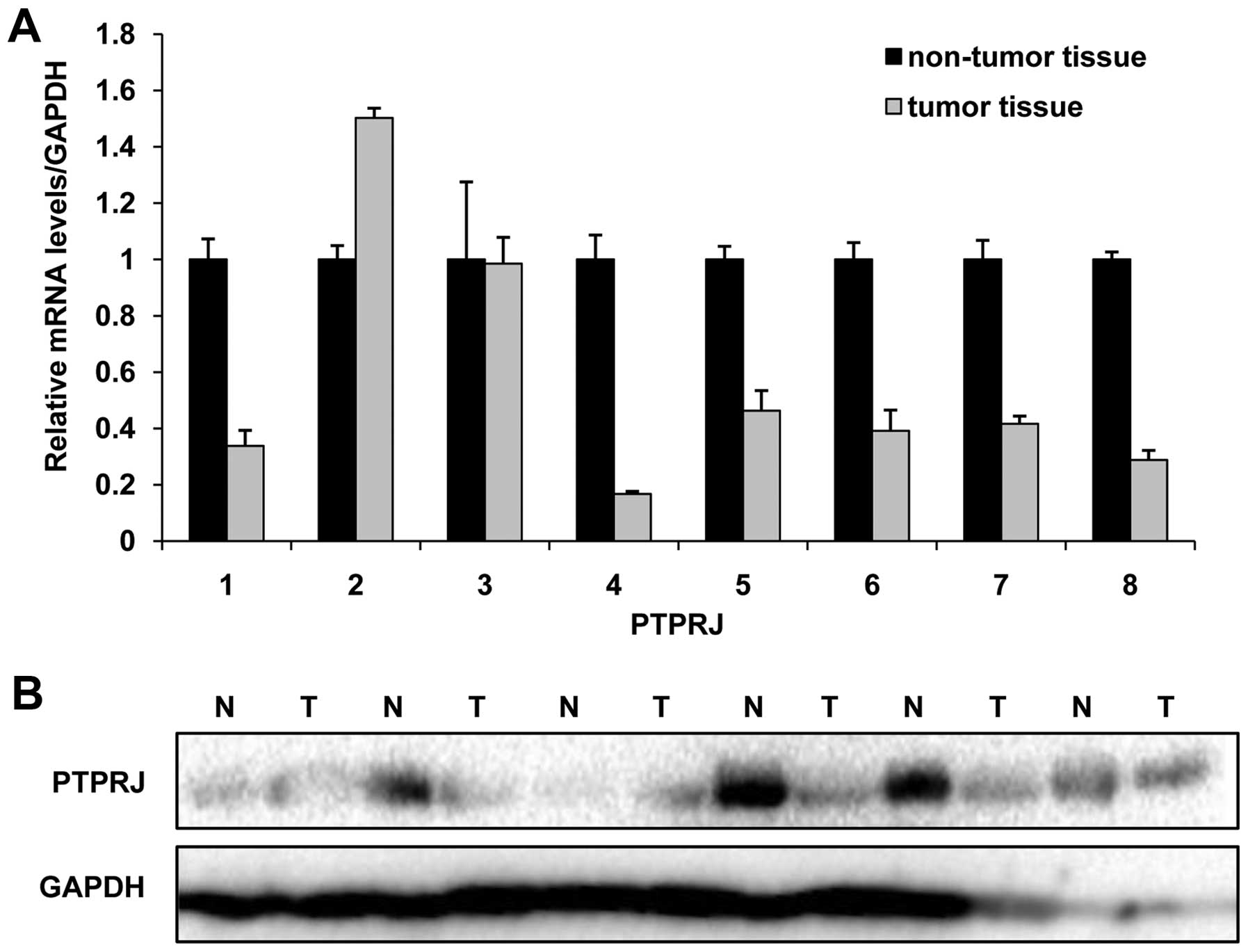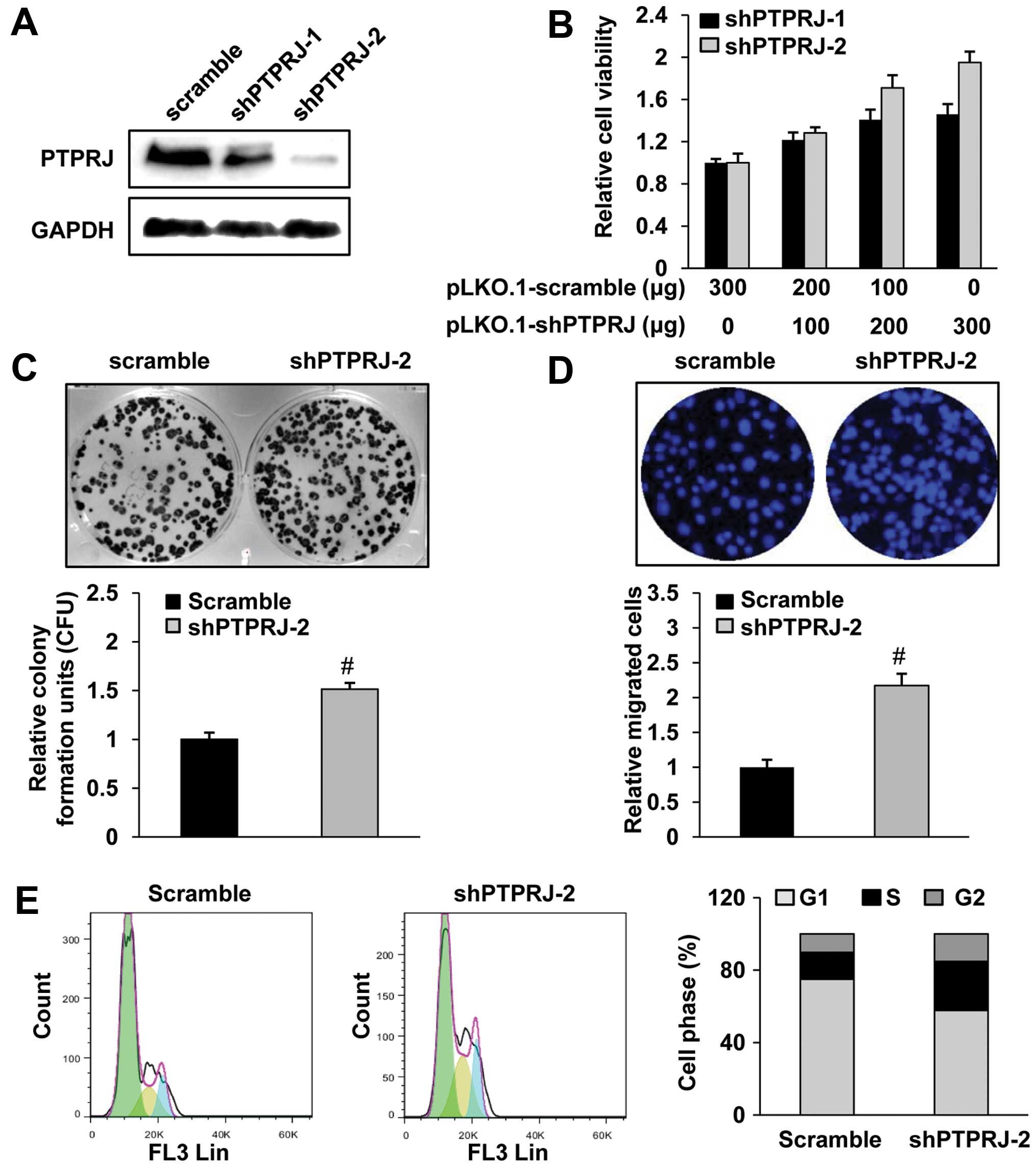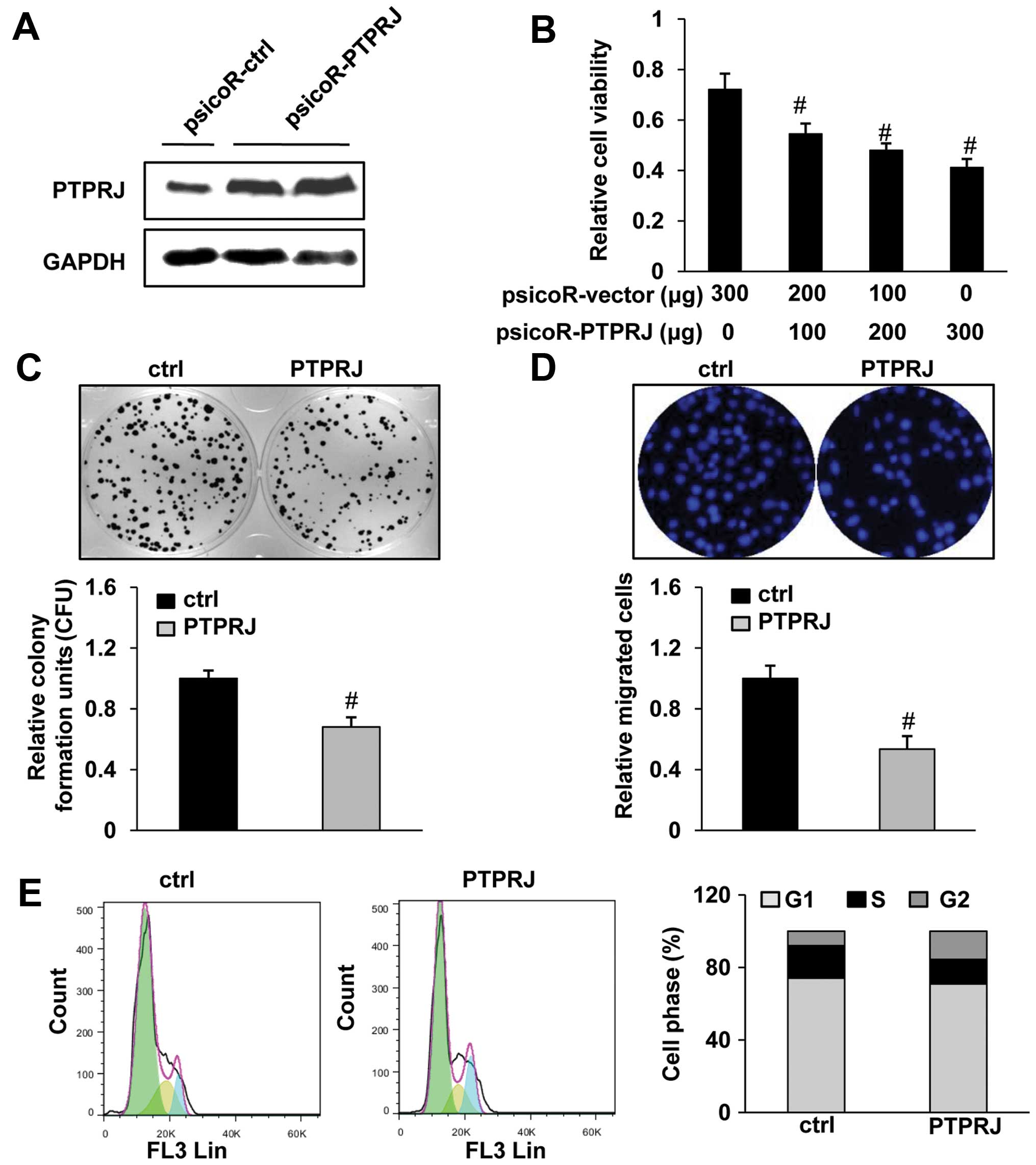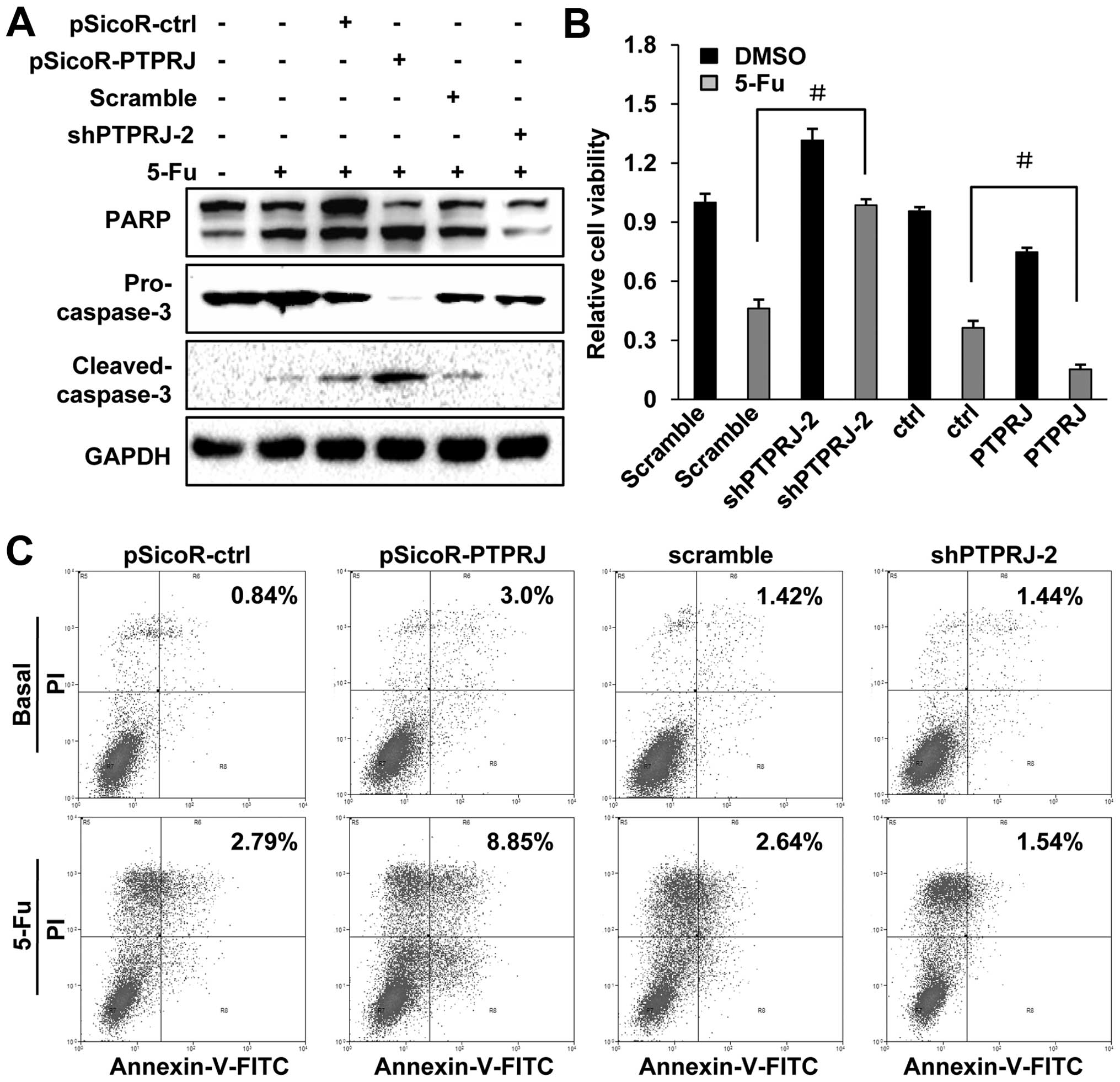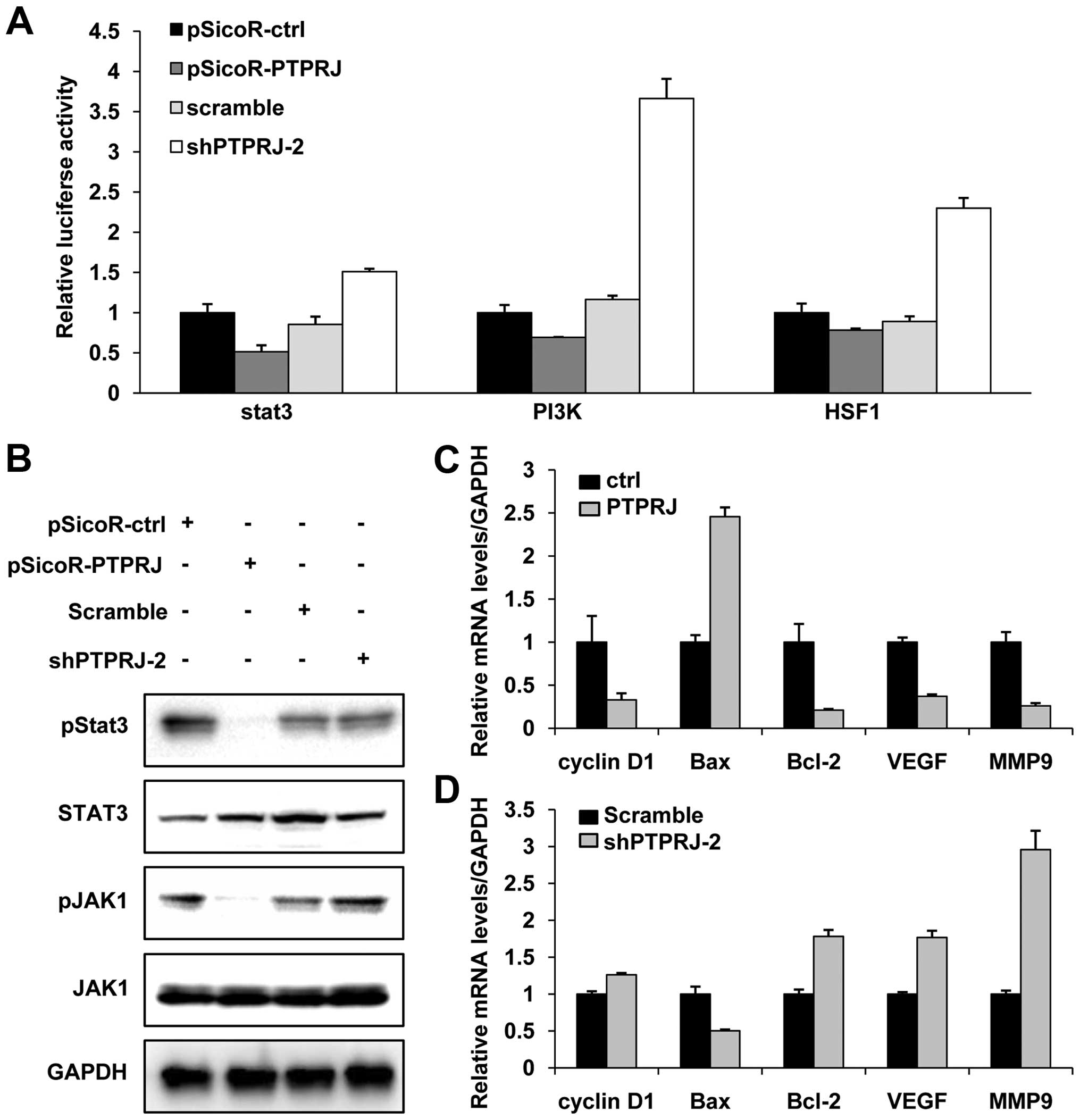Blockage of PTPRJ promotes cell growth and resistance to 5-FU through activation of JAK1/STAT3 in the cervical carcinoma cell line C33A
- Authors:
- Published online on: January 29, 2015 https://doi.org/10.3892/or.2015.3769
- Pages: 1737-1744
Abstract
Introduction
Cervical cancer is the second most common cancer among women worldwide and it is a leading cause of cancer-related deaths (1). It is widely accepted that cervical cancer is caused by HPV infections and expression of oncogenes, such as c-MYC, Ha-RAS and ERB-2 (2,3). Cervical cancer is generally curable when detected early, but treatment of this cancer is poorly effective and is usually accompanied by adverse effects. Gene therapy is a promising therapeutic approach for chemoresistant cervical cancers (4–6). Hence, therapeutic interventions targeting the key factors contributing to the initiation and progression of cervical cancer may be a more effective treatment strategy.
The protein tyrosine phosphatase receptor J (PTPRJ) is a 220-kDa transmembrane protein that belongs to the family of receptor-type protein tyrosine phosphatases which are involved in multiple signaling pathways (7). PTPRJ is expressed in many cancer cell lines, including breast, colorectal, lung cancers and mammary and pancreatic tumors. Previous studies demonstrated that PTPRJ is a candidate tumor suppressor and its overexpression in different carcinoma cell lines negatively regulates cell proliferation and transformation (7–10). Mechanistically, the anti-proliferative effect of PTPRJ may account for its inhibition of growth factor signaling through the dephosphorylation of various receptor tyrosine kinases, such as FLT3, PDGFR, VEGFR2, MET, and ERK1/2 (11–15). However, the roles and function mechanism of PTPRJ in human cervical carcinoma remain largely unknown.
Here, we analyzed the expression of PTPRJ in human cervical tumor and non-tumor tissues and observed a striking downregulation of PTPRJ in cancer tissues. We further showed that PTPRJ functioned as a negative regulator of cell proliferation and migration in the human cervical cancer cell line C33A. In addition, sustained inhibition of PTPRJ increased the cell resistance to 5-fluorouracil (5-FU)-induced apoptosis while high levels of PTPRJ accelerated cell death. Mechanistically, PTPRJ decreased the phosphorylation levels of Janus kinase 1 (JAK1) and signal transducer and activator of signal transducer and activator of transcription 3 (stat3) and modulated the expression of the downstream factors of the JAK1/stat3 signaling pathway. The present study provided a clinical guide to the treatment of human cervical cancer.
Materials and methods
Tumor samples
For the analysis of mRNA and protein levels of PTPRJ, 8-paired human cervical tumor and non-tumor samples were obtained from patients with stage I–III adenocarcinoma and immediately frozen in liquid nitrogen and stored at the Department of Pathology, Gansu Provincial Hospital in Lanzhou, China. Immunochemistry methods were used to characterize these tissues.
Cells and reagents
Human cervical carcinoma cell line, C33A, was purchased from the American Type Culture Collection (Rockville, MD, USA) and maintained in RPMI-1640 (Invitrogen Corp., Carlsbad, CA, USA) supplemented with 10% fetal bovine serum (Hyclone, South Logan, UT, USA), 100 U/ml penicillin and 100 mg/ml streptomycin at 37°C in a humidified incubator with 5% CO2. 5-FU was obtained from Sigma Chemical.
Plasmid construction
PTPRJ cDNA was PCR amplified from the whole genome of HEK293T using primers for PTPRJ: 5′-ATGAAGCCGGCGGCGCGGGA-3′ (sense) and 5′-TTAGGCGATGTAACCATTGG-3′ (antisense). The cDNAs were ligated into pSicoR after being digested by EcoRI and XhoI to create pSicoR-PTPRJ. RNA interference vectors used in the present study were constructed in pLKO.1 puro. Target sequences are as follows: NTC (AATTCTCCGAACGTGTCACGT), shPTPRJ-1 (ACGAGTCGTCATCTAACTATA), shPTPRJ-2 (CCGATACAATGCCACCGTTTA).
Stable cell line establishment and treatment
The indicated constructs were transfected into the HEK293T cells in combination with the lentiviral packaging vectors pRSV-Rev, pMD2.G, and pCMV-VSV-G using Lipofectamine 2000 (Invitrogen). After 60 h, the media containing the viruses were collected using a 0.22-μm filter (Millipore, Bedford, MA, USA). Viral supernatant from a 6-well plate was used to infect ~103 C33A cells for 48 h. After a 24-h infection, the C33A cells were selected for 48 h in 2.5 μg/ml puromycin and two colonies were chosen to expand and detect the protein levels. For 5-FU treatment, the indicated stable cell lines were plated in 6-well plates and cultured for 24 h. Then the culture media were changed with fresh DMEM containing 20 μg/ml 5-FU or DMSO.
Western blotting
The cells were washed with PBS and lysed in ice-cold lysis buffer consisting of 50 mM Tris-HCl (pH 8.0), 150 mM NaCl, 1% NP-40, 0.5% sodium deoxycholate, 0.1% SDS along with phosphatase and protease inhibitors. After sonication on ice, protein lysates were obtained by centrifugation at 12,000 × g at 4°C for 10 min. The protein concentration was determined using the BCA assay. Fifty micrograms of the total protein was mixed with 4X loading buffer [360 mM TrisHCl (pH 6.8), 30% glycerol and 10% SDS]. The protein samples were then heated at 95°C for 5 min and electroseparated using 10% sodium dodecyl sulfate-polyacrylamide gel electrophoresis (SDS-PAGE) and transferred onto a PVDF membrane (Immobilon-P; Millipore). After being blocked with 0.5% skim milk, the membrane was probed with a monoclonal antibody for PTPRJ (R&D, MAB1934), or PARP (#9532), pro-caspase-3 (#9665), cleaved-caspase-3 (#9661), phospho-STAT3 (Tyr705) (#9145), phospho-JAK1 (Tyr1022/1023) (#3331), STAT3 (#9132), JAK1 (#1013) and GAPDH (#3683), which were purchased from Cell Signaling Technology. The membrane was then incubated with a horseradish peroxidase-conjugated secondary antibody and developed with the SuperSignal chemiluminescence kit (Immobilon Western Chemiluminescent HRP Substrate; EMD Millipore).
Cell viability and proliferation assays
C33A cells were cultured into 96-well plates at ~5,000 cells/well. After 24 h at 37°C, the cells were transfected with the indicated plasmids and allowed another 48-h culture. Cell viability was assessed using the Dojindo Cell Counting Kit-8 (CCK-8; Dojindo Molecular Technologies, Kumamoto, Japan). Experiments were performed in octuplicate. For the colony formation assay, the stable C33A cells were cultured in a 6-well tissue culture plate at 500 cells/well. Cells were grown for 10–14 days. After being fixed by 4% paraformaldehyde for 30 min, the colonies were stained with 0.1% crystal violet for 15 min and washed. The colonies were counted by Image J software.
Transwell migration assay
Stable C33A cells (200 μl) in RPMI-1640 medium without FBS were loaded into the upper chambers of BD Falcon™ Cell Culture Inserts (8-μm pore size; 1×105 cells/chamber). The lower chambers were filled with 800 μl medium (RPMI-1640 plus 10% FBS). After a 24-h incubation at 37°C, the cells were fixed with paraformaldehyde and stained with 4′,6-diamidino-2-phenylindole (DAPI). The stained cells on the lower side were observed under a fluorescence microscope. Three fields per chamber were photographed and the number of migrated cells was counted by Image J software.
Pathway screening assay
Signaling pathway arrays were conducted by a luciferase assay. Reporters HSF1-luc, phos-phatidylinositol-4,5-bisphosphate 3-kinase (PI3K)/AKT-luc and STAT3-luc were purchased from Qiagen (Valencia, CA, USA). C33A cells were cotransfected with reporter plasmids and pSicoR-PTPRJ or shPTPRJ in 24-well plates. After 48 h, the cells were lysed in 1X reporter lysis buffer (Promega, Madison, WI, USA) and the luciferase activity was measured by a Dual-Luciferase® Reporter assay system (Promega). Experiments were conducted in triplicates and repeated at least three times.
Real-time PCR
Total RNA was isolated using a TRIzol RNA extraction kit, and 1 μg of RNA was reverse transcribed into cDNA according to the manufacturer’s instructions (RevertAid First strand cDNA Synthesis kit; Thermo). Real-time PCR was performed to measure the expression of cyclin D1, Bcl-2, Bax, VEGF and MMP9. The following primers were used: GAPDH-F, 5′-TGCACCACCAACTGCTTAGC-3′ and GAPDH-R, 5′-GCATGGACTGTGGTCATGAG-3′; BAX-F, 5′-GAGGATGATTGCCGCCGTGGACA-3′and BAX-R, 5′-GGTGGGGGAGGAGGCTTGAGG-3′; Bcl-2-F, 5′-ATG TGTGTGGAGAGCGTCAACC-3′ and Bcl-2-R, 5′-TGAGCAG AGTCTTCAGAGACAGCC-3′; MMP9-F, 5′-CCTGGAGAC CTGAGAACCAATC-3′ and MMP9-R, 5′-CCACCCGAGT GTAACCATAGC-3′; and VEGF-F, 5′-TGCCCACTGAGGA GTCCAAC-3′ and VEGF-R, 5′-TGGTTCCCGAAACGC TGA G-3′. All samples were read in triplicate, and values were normalized to GAPDH expression.
Cell cycle analysis
The stable C33A cells were harvested and washed twice with PBS and fixed in 70% cold ethanol at 4°C overnight. Before the analysis, the cells were washed twice with PBS, and then resuspended with 400 μl PBS and 100 μg/ml RNaseA (Sigma) and 50 μg/ml propidium iodide (PI) (Sigma). After incubation for 30 min at 37°C, the cells were subjected to DNA content analysis using a FACS Calibur (Becton Dickinson, San Jose, CA, USA). The results were analyzed with Flowjo software.
Statistical analysis
SPSS 19 software was used for statistical analyses. Data are presented as means ± SD. Statistical significance was determined by the Student’s t-test in some experiments. Differences with P-values of <0.05 were considered significant.
Results
PTPRJ is downregulated in human cervical tumor tissues
PTPRJ is widely regarded as a tumor suppressor and its expression is decreased in various tumor types. In the present study, we analyzed the mRNA and protein levels of PTPRJ in 8-paired patient samples. We observed that both the mRNA and protein levels of PTPRJ were decreased in the majority of the examined tumor tissues (75%). There was a >50% decrease in 6-paired tumor and non-tumor tissues (Fig. 1A and B).
Suppression of PTPRJ promotes cell growth and migration in the cervical cancer C33A cells
To investigate the role of PTPRJ in the C33A cell line, we used construct codings for two different shRNAs against PTPRJ or a control shRNA. After puromycin selection, we obtained the stable cell lines expressing shPTPRJ. The PTPRJ shRNAs effectively decreased the mRNA and protein levels of PTPRJ, as determined by western blotting (Fig. 2A).
To assess whether the modulation of PTPRJ level influences the tumorigenetic properties of the C33A cells, we measured the cell viability, proliferation and migration capabilities by using these stable cell lines or transfected C33A cells with various doses of the indicated plasmids. By the CCK8 assay, we observed that the shPTPRJ-transfected cells showed an increased cell viability in a dose-dependent manner (Fig. 2B). By a colony formation assay, we observed that the shPTPRJ-infected C33A cells exhibited increased proliferation (Fig. 2C). To further investigate the role of PTPRJ in cell migration, we performed an invasion assay by using a Transwell chamber under serum-starved conditions. We found that the shPTPRJ infection significantly enhanced the C33A cell invasive ability by ~2.2-fold relative to the scramble infection (Fig. 2D). Finally, the cell cycle distribution of the shPTPRJ/scramble-infected C33A cells was measured by use of propidium iodide staining. As shown in Fig. 2E, the percentage of shPTPRJ-infected cells in the G1 phase was considerably decreased with significantly increased percentages of cells in the S and G2/M phases, in comparison to the scramble-infected cells.
Re-expression of PTPRJ suppresses cell viability, proliferation and migration of the C33A cells
To identify the effects of PTPRJ re-expression on the cell proliferation of C33A cells, we generated a stable cell line with high endogenous PTPRJ levels (Fig. 3A). C33A cells with an increased PTPRJ expression had a growth disadvantage, as assessed by the CCK-8 assay (Fig. 3B). Consistent with the previous studies in other cervical cancer cells such as HeLa (16), cell proliferation in the PTPRJ-overexpressing C33A cells was obviously reduced as compared to the corresponding control cells, confirming the antiproliferative activity of PTPRJ in the cervical cancer cell line C33A (Fig. 3C). We further used the PTPRJ-expressing C33A cells to perform a cell migration assay. Our results revealed that PTPRJ upregulation effectively reduced cell migration toward the serum starvation (Fig. 3D). By cell cycle analysis, we observed that the PTPRJ-overexpressing cells had a clearly decreased S-phase proportion and increased G2/M arrest (Fig. 3E).
Downregulation of PTPRJ enhances 5-FU-induced cell apoptosis in the C33A cells
5-FU is an important and widely used anticancer drug, including cervical cancer. However, tumor cell resistance to 5-FU-induced cell death often occurs during clinical treatment (17). The PTPRJ agonist has been shown to induce cell apoptosis (18). To investigate the role of PTPRJ in 5-FU-induced cell apoptosis, we conducted western blotting to detect the expression of caspase-3 and PARP, the effective markers for cell apoptosis. Our results revealed that cleaved-caspase-3 and cleaved-PARP were upregulated after treating the wild-type C33A cells with 50 μg/ml 5-FU, while the levels of pro-caspase-3 and full-length PARP were decreased. In the stable C33A cell line that overexpressed PTPRJ, the levels of pro-caspase-3 and full-length PARP were significantly lower, and the levels of cleaved-caspase-3 and cleaved-PARP were higher than the levels in the control group, after treatment with an equal dose of 5-FU (50 μg/ml). In contrast, pro-caspase-3 and full-length PARP were increased, while cleaved-caspase-3 and cleaved-PARP were decreased in the stable cell line expressing shPTPRJ (Fig. 4A).
Next, using the CCK-8 assay, we measured the cell viability of the wild-type C33A cells and PTPRJ/shPTPRJ stable cell lines after treatment with 5-FU. As expected, when given the 5-FU treatment, the viability of the stable cell line expressing shPTPRJ was obviously higher than the wild-type cells, while cells overexpressing PTPRJ showed a decreased cell viability, when compared with the wild-type cells (Fig. 4B).
In addition, the stable transfectants were treated with DMSO or 5-FU and subjected to FACS assays. At the basal state, the apoptotic rates of the cells transfected with the indicated genes remained unchanged. When the cells were exposed to 5-FU, ectopic overexpression of PTPRJ obviously increased the percentage of apoptotic cells, while inhibition of PTPRJ by shPTPRJ-2 attenuated the 5-FU-induced cell apoptosis, compared with the cells transfected with pSicoR-control or scramble, respectively (Fig. 4C). All things considered, the inhibition of PTPRJ decreased the sensitivity of C33A to 5-FU-induced cell apoptosis.
The activities of pJAK1 and pSTAT3 are modulated by PTPRJ in the C33A cells
PTPRJ is a receptor-like protein-tyrosine phosphatase that directly regulates the dephosphorylation of several receptor tyrosine kinases, including FLT3, ERK, PDGFR. Omerovic et al (19) reported that PTPRJ negatively regulated serine/threonine protein kinase B (AKT) phosphorylation in Ras-mutated cancer cells. In accordance with previous studies, during the pathway screening assay, we observed that the luciferase activity of the PI3K/AKT pathway was decreased in the C33A cells transfected with PTPRJ, while inhibition of PTPRJ by shRNA led to an apparent increase in the activity of the PI3K/AKT pathway (Fig. 5A). Interestingly, we observed a similar change of heat shock transcription factor 1 (HSF1) and STAT3 pathway (Fig. 5A). STAT3 is crucial for cell proliferation, differentiation and apoptosis (20–22). STAT3 is regulated by JAK1 and other stimuli or proteins. In cervical cancer, STAT3 was reported to be correlated with clinical stage and positive-pSTAT3 patients have a favorable prognosis (23,24). Given the dephosphorylation activity of PTPRJ, we analyzed the phosphorylated levels of JAK1 and STAT3. The western blotting showed that the levels of pJAK1 and pSTAT3 were decreased while the total protein levels of JAK1 and STAT3 were constant when the cells were transfected with PTPRJ. On the contrary, shPTPRJ transfection caused the upregulation of the levels of pJAK1 and pSTAT3 (Fig. 5B).
To confirm the effect of PTPRJ on the JAK1/STAT3 pathway, the mRNA levels of cyclin D1, Bax, Bcl-2, VEGF and MMP9, downstream effectors of STAT3, were measured by real-time PCR. The levels of cyclin D1, Bcl-2, VEGF and MMP9 were decreased, and the expression of Bax was increased in the cells transfected with PTPRJ (Fig. 5C). We obtained the opposite results in the cells transfected with shPTPRJ (Fig. 5D). Collectively, these results revealed a negative regulation of PTPRJ on the JAK/STAT3 signaling pathway.
Discussion
Cervical cancer is a leading cause of cancer-related deaths. PTPRJ is known to negatively regulate cell growth in many malignant tumors by phosphorylation of different substrates, but the understanding of its signaling transduction in cervical cancer is limited. The present study reports for the first time that PTPRJ plays an important role in proliferation and migration of the cervical cancer cell line C33A. PTPRJ regulates cell cycle progression and cell apoptosis induced by 5-FU and these processes are mediated via suppression of the phosphorylated levels of AKT and ERK. Our results suggest that PTPRJ may be a promising therapeutic target for cervical cancer treatment.
The tumor-suppressor effect of PTPRJ is well documented in breast tumors (25), liver cancer (14), acute myeloid leukemia (11) and colorectal cancer (26). Recent studies showed that the PTPRJ agonist effectively inhibits cell proliferation and triggers apoptosis of breast cancer cells (16). Accordingly, the present study showed that downregulation of PTPRJ is correlated with promotion of cell proliferation, migration and the G1-S phase transition. In contrast, the ectopic overexpression of PTPRJ effectively inhibited cancer cell growth and induced cell cycle arrest. The present study established the tumor-suppressor role of PTPRJ in C33A cells.
PTPRJ and other members of the PTP family have been reported to be involved in the cell susceptibility to a variety of human-related cancers (27). 5-FU is the most extensively studied agent in cancer treatment. However, acquired drug resistance and severe side effects limit the effectiveness of chemotherapy (17). Previous research showed that the anti-cancer efficacy of 5-FU can be synergistically promoted when used in combination with gene therapy, which may be tumor suppressor-based or RNAi-based (28–31). In the present study, knockdown of PTPRJ increased the C33A cell resistance to 5-FU-induced apoptosis, whereas ectopic expression of PTPRJ increased the cell apoptosis in the C33A cells.
Sufficient evidence has emerged that AKT is a key regulator of cell survival and it contributes to cell susceptibility to chemotherapy in different types of tumors (32,33). The activation of AKT could be regulated by PTPRJ. Consistent with the previous study, we observed that PTPRJ significantly reduced the activity of the PI3K/AKT pathway. A novel finding of the present study was the regulatory effect of PTPRJ on the JAK1/STAT3 axis. STAT3 is a key transcription factor involved in numerous cell signal transduction networks and numerous studies have implicated the potential of STAT3 as a therapeutic target for the treatment of different types of cancer (34,35). We found that PTPRJ modulated the phosphorylation levels of JAK1 and STAT3. The mRNA levels of the downstream effectors of the STAT3 pathway were altered when the cells were transfected with PTPRJ or shPTPRJ. Notably, the expression of Bcl-2, an important anti-apoptotic factor, was downregulated and the pro-apoptotic factor, Bax, was upregulated when PTPRJ was overexpressed in C33A cells. This may explain why the ectopic overexpression of PTPRJ accelerated 5-FU-induced cell apoptosis. Collectively, these results suggest that STAT3 is a substrate of PTPRJ and further study is needed to reveal whether this effect is due to the direct interaction between PTPRJ and STAT3.
All things considered, the present study demonstrated that blockage of PTPRJ significantly promoted tumor biological features and upregulation of PTPRJ led to inhibition of the growth of the C33A cells. Furthermore, our findings provide novel evidence that PTPRJ is a regulator of cell apoptosis induced by 5-FU. Sustained PTPRJ overexpression modulated the phosphorylated levels of JAK1/STAT3, and the downstream factors such as Bcl-2, Bax, cyclin D1, which were critical mediators of cell processes like cell apoptosis and proliferation. These data suggest that PTPRJ may serve as a potential target for cervical cancer therapy.
Acknowledgements
We thank Professor Jun Zhu and Dr Zhong Tian Bai for their assistance with the construction of the lentiviral vectors and the establishment of the stable cell lines and Yong Xiu Yang for his staff support.
Abbreviations:
|
PTPRJ |
protein tyrosine phosphatase receptor J |
|
STAT3 |
signal transducer and activator of transcription 3 |
|
JAK1 |
Janus kinase 1 |
|
Bax |
B cell lymphoma 2-associated X protein |
|
Bcl-2 |
B cell lymphoma 2 |
|
PI3K |
phosphatidylinositol-4,5-bisphosphate 3-kinase |
|
AKT |
serine/threonine protein kinase B |
|
HSF1 |
heat shock transcription factor 1 |
|
5-FU |
5-fluorouracil |
|
VEGF |
vascular endothelial growth factor |
|
MMP9 |
matrix metalloproteinase 9 |
References
|
Parkin DM and Bray F: Chapter 2: The burden of HPV-related cancers. Vaccine. 24(Suppl 3): S3/11–25. 2006. View Article : Google Scholar | |
|
Ronco G, Dillner J, Elfström KM, et al: Efficacy of HPV-based screening for prevention of invasive cervical cancer: follow-up of four European randomised controlled trials. Lancet. 383:524–532. 2013. View Article : Google Scholar : PubMed/NCBI | |
|
Pinion SB, Kennedy JH, Miller RW and MacLean AB: Oncogene expression in cervical intraepithelial neoplasia and invasive cancer of cervix. Lancet. 337:819–820. 1991. View Article : Google Scholar : PubMed/NCBI | |
|
Jeon YH, Lee HW, Lee YL, et al: Combined E7-dendritic cell-based immunotherapy and human sodium/iodide symporter radioiodine gene therapy with monitoring of antitumor effects by bioluminescent imaging in a mouse model of uterine cervical cancer. Cancer Biother Radiopharm. 26:671–679. 2011. View Article : Google Scholar : PubMed/NCBI | |
|
Koch M and Wiese M: Gene expression signatures of angiocidin and darapladib treatment connect to therapy options in cervical cancer. J Cancer Res Clin Oncol. 139:259–267. 2013. View Article : Google Scholar | |
|
Zheng Y, Chen H, Zeng X, et al: Surface modification of TPGS-b-(PCL-ran-PGA) nanoparticles with polyethyleneimine as a co-delivery system of TRAIL and endostatin for cervical cancer gene therapy. Nanoscale Res Lett. 8:1612013. View Article : Google Scholar : PubMed/NCBI | |
|
Keane MM, Lowrey GA, Ettenberg SA, Dayton MA and Lipkowitz S: The protein tyrosine phosphatase DEP-1 is induced during differentiation and inhibits growth of breast cancer cells. Cancer Res. 56:4236–4243. 1996.PubMed/NCBI | |
|
Iuliano R, Trapasso F, Le Pera I, et al: An adenovirus carrying the rat protein tyrosine phosphatase eta suppresses the growth of human thyroid carcinoma cell lines in vitro and in vivo. Cancer Res. 63:882–886. 2003.PubMed/NCBI | |
|
Massa A, Barbieri F, Aiello C, et al: The expression of the phosphotyrosine phosphatase DEP-1/PTPeta dictates the responsivity of glioma cells to somatostatin inhibition of cell proliferation. J Biol Chem. 279:29004–29012. 2004. View Article : Google Scholar : PubMed/NCBI | |
|
Trapasso F, Iuliano R, Boccia A, et al: Rat protein tyrosine phosphatase eta suppresses the neoplastic phenotype of retrovirally transformed thyroid cells through the stabilization of p27(Kip1). Mol Cell Biol. 20:9236–9246. 2000. View Article : Google Scholar : PubMed/NCBI | |
|
Godfrey R, Arora D, Bauer R, et al: Cell transformation by FLT3 ITD in acute myeloid leukemia involves oxidative inactivation of the tumor suppressor protein-tyrosine phosphatase DEP-1/ PTPRJ. Blood. 119:4499–4511. 2012. View Article : Google Scholar : PubMed/NCBI | |
|
Kovalenko M, Denner K, Sandstrom J, et al: Site-selective dephosphorylation of the platelet-derived growth factor beta-receptor by the receptor-like protein-tyrosine phosphatase DEP-1. J Biol Chem. 275:16219–16226. 2000. View Article : Google Scholar : PubMed/NCBI | |
|
Lampugnani MG, Orsenigo F, Gagliani MC, Tacchetti C and Dejana E: Vascular endothelial cadherin controls VEGFR-2 internalization and signaling from intracellular compartments. J Cell Biol. 174:593–604. 2006. View Article : Google Scholar : PubMed/NCBI | |
|
Palka HL, Park M and Tonks NK: Hepatocyte growth factor receptor tyrosine kinase met is a substrate of the receptor protein-tyrosine phosphatase DEP-1. J Biol Chem. 278:5728–5735. 2003. View Article : Google Scholar | |
|
Sacco F, Tinti M, Palma A, et al: Tumor suppressor density-enhanced phosphatase-1 (DEP-1) inhibits the RAS pathway by direct dephosphorylation of ERK1/2 kinases. J Biol Chem. 284:22048–22058. 2009. View Article : Google Scholar : PubMed/NCBI | |
|
Ortuso F, Paduano F, Carotenuto A, et al: Discovery of PTPRJ agonist peptides that effectively inhibit in vitro cancer cell proliferation and tube formation. ACS Chem Biol. 8:1497–1506. 2013. View Article : Google Scholar : PubMed/NCBI | |
|
Longley DB, Harkin DP and Johnston PG: 5-fluorouracil: mechanisms of action and clinical strategies. Nat Rev Cancer. 3:330–338. 2003. View Article : Google Scholar : PubMed/NCBI | |
|
Paduano F, Ortuso F, Campiglia P, et al: Isolation and functional characterization of peptide agonists of PTPRJ, a tyrosine phosphatase receptor endowed with tumor suppressor activity. ACS Chem Biol. 7:1666–1676. 2012. View Article : Google Scholar : PubMed/NCBI | |
|
Omerovic J, Clague MJ and Prior IA: Phosphatome profiling reveals PTPN2, PTPRJ and PTEN as potent negative regulators of PKB/Akt activation in Ras-mutated cancer cells. Biochem J. 426:65–72. 2010. View Article : Google Scholar | |
|
Aggarwal BB, Kunnumakkara AB, Harikumar KB, et al: Signal transducer and activator of transcription-3, inflammation, and cancer: how intimate is the relationship? Ann NY Acad Sci. 1171:59–76. 2009. View Article : Google Scholar : PubMed/NCBI | |
|
Aggarwal BB, Sethi G, Ahn KS, et al: Targeting signal-transducer-and-activator-of-transcription-3 for prevention and therapy of cancer: modern target but ancient solution. Ann NY Acad Sci. 1091:151–169. 2006. View Article : Google Scholar | |
|
Ihle JN: Cytokine receptor signalling. Nature. 377:591–594. 1995. View Article : Google Scholar : PubMed/NCBI | |
|
Sobti RC, Singh N, Hussain S, Suri V, Bharti AC and Das BC: Overexpression of STAT3 in HPV-mediated cervical cancer in a north Indian population. Mol Cell Biochem. 330:193–199. 2009. View Article : Google Scholar : PubMed/NCBI | |
|
Choi CH, Song SY, Kang H, et al: Prognostic significance of p-STAT3 in patients with bulky cervical carcinoma undergoing neoadjuvant chemotherapy. J Obstet Gynaecol Res. 36:304–310. 2010. View Article : Google Scholar : PubMed/NCBI | |
|
Smart CE, Askarian Amiri ME, Wronski A, et al: Expression and function of the protein tyrosine phosphatase receptor J (PTPRJ) in normal mammary epithelial cells and breast tumors. PLoS One. 7:e407422012. View Article : Google Scholar : PubMed/NCBI | |
|
Toland AE, Rozek LS, Presswala S, Rennert G and Gruber SB: PTPRJ haplotypes and colorectal cancer risk. Cancer Epidemiol Biomarkers Prev. 17:2782–2785. 2008. View Article : Google Scholar : PubMed/NCBI | |
|
Mita Y, Yasuda Y, Sakai A, et al: Missense polymorphisms of PTPRJ and PTPN13 genes affect susceptibility to a variety of human cancers. J Cancer Res Clin Oncol. 136:249–259. 2010. View Article : Google Scholar | |
|
Lv XG, Ji MY, Dong WG, et al: EBP50 gene transfection promotes 5-fluorouracil-induced apoptosis in gastric cancer cells through Bax- and Bcl-2-triggered mitochondrial pathways. Mol Med Rep. 5:1220–1226. 2012.PubMed/NCBI | |
|
Taiyoh H, Kubota T, Fujiwara H, et al: NK4 gene expression enhances 5-fluorouracil-induced apoptosis of murine colon cancer cells. Anticancer Res. 31:2217–2224. 2011.PubMed/NCBI | |
|
Tian F, Fan T, Jiang Y, Zhang X and Wang X: A small interfering RNA targeting NF-kappaB p65 alone or combined with 5-FU inhibits growth of esophageal squamous cell carcinoma in nude mice. Pathol Res Pract. 208:32–38. 2012. View Article : Google Scholar | |
|
Xie Q, Liang BL, Wu YH, et al: Synergistic anticancer effect of rAd/P53 combined with 5-fluorouracil or iodized oil in the early therapeutic response of human colon cancer in vivo. Gene. 499:303–308. 2012. View Article : Google Scholar : PubMed/NCBI | |
|
McCubrey JA, Steelman LS, Abrams SL, et al: Roles of the RAF/MEK/ERK and PI3K/PTEN/AKT pathways in malignant transformation and drug resistance. Adv Enzyme Regul. 46:249–279. 2006. View Article : Google Scholar : PubMed/NCBI | |
|
Zhang LH, Yin AA, Cheng JX, et al: TRIM24 promotes glioma progression and enhances chemoresistance through activation of the PI3K/Akt signaling pathway. Oncogene. Jan 27–2014.(Epub ahead of prin). View Article : Google Scholar | |
|
Kamran MZ, Patil P and Gude RP: Role of STAT3 in cancer metastasis and translational advances. Biomed Res Int. 2013:4218212013. View Article : Google Scholar : PubMed/NCBI | |
|
Gong J, Muñoz AR, Chan D, Ghosh R and Kumar AP: STAT3 down regulates LC3 to inhibit autophagy and pancreatic cancer cell growth. Oncotarget. 5:2529–2541. 2014.PubMed/NCBI |



